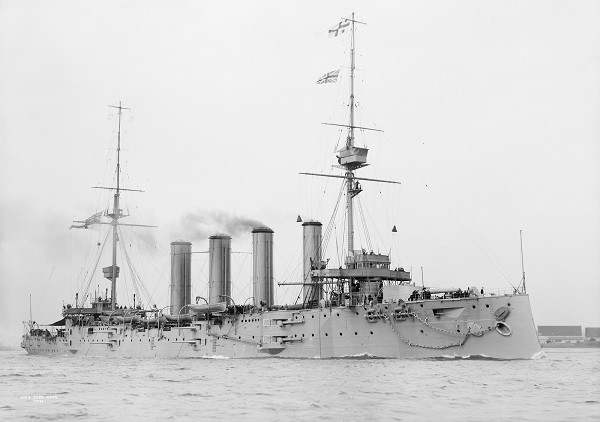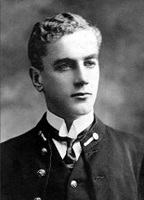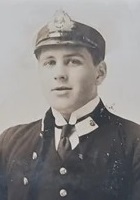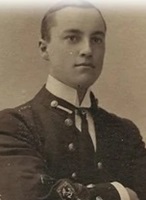|
HMS GOOD HOPE
Drake Class Armoured Cruiser
HMS Good Hope Click on the above photo to view a larger image
This page is not meant to be a comprehensive history of HMS Good Hope, but a record of sailors of the ROYAL CANADIAN NAVY who served in her, photos they took and stories they may have shared with their families.
Good Hope, named after the British colony on the Cape of Good Hope, was laid down on 11 September 1899 with the name of Africa by Fairfield Shipbuilding & Engineering at their Govan shipyard. She was renamed Good Hope on 2 October and launched on 21 February 1901, when she was formally named by Mrs. (Ethel) Elgar, wife of Francis Elgar, manager of the shipbuilding company. She arrived in Portsmouth to be completed and armed in late December 1901. Captain Charles Edward Madden was appointed in command as she was completed in late 1902.
In 1906 she became the flagship of the 1st Cruiser Squadron, Atlantic Fleet and was the flagship of the 2nd Cruiser Squadron when she visited South Africa two years later. Good Hope was placed in reserve in 1913.
Upon re-commissioning in mid-1914, she was briefly assigned to the 6th Cruiser Squadron in August before being assigned to the 4th Cruiser Squadron to reinforce Cradock's forces. He transferred his flag to her because she was faster than his previous flagship. Cradock's command was transferred to the coast of South America later that month at his own suggestion to better hunt for the German ships preying upon British merchant ships. His ships were generally unsuccessful in this and he moved his squadron further south in late September to search for the East Asia Squadron, under the command of Vice Admiral Graf Maximilian von Spee, in the vicinity of Cape Horn and the Strait of Magellan in accordance to his orders from the Admiralty.
At the end of September, Cradock made his first fruitless search of the Tierra del Fuego area and later detached three of his ships to search up the Chilean coast, reaching Valparaiso on 15 October, while Good Hope returned to Port Stanley, in the Falkland Islands, to re-coal and to reestablish communications with the Admiralty. He received word on 7 October that Spee's ships were definitely bound for the Cape Horn region and waited for the elderly pre-dreadnought battleship Canopus to reinforce his squadron. She was in poor mechanical condition when she arrived at Port Stanley and required time to make repairs. Good Hope sailed on 22 October without her, going around Cape Horn, while Canopus and three colliers departed the following day, taking the shorter route through the Strait of Magellan.
Good Hope rendezvoused with the rest of the squadron at Vallenar Roads in the remote Chonos Archipelago of Chile on 27 October to re-coal. They departed two days later, just as Canopus arrived, Cradock ordering the battleship to follow as soon as possible. He sent the light cruiser Glasgow to scout ahead and to enter Coronel, Chile to pick up any messages from the Admiralty and acquire intelligence regarding German activities. The cruiser began to pick up German radio signals from the light cruiser SMS Leipzig on the afternoon of 29 October, and delayed entering Coronel for two days with Cradock's permission to avoid being trapped by the fast German ships. A German supply ship was already there and radioed Spee that Glasgow had entered the harbour around twilight. The cruiser departed on the morning of 1 November, but Spee had already made plans to catch her when informed of her presence the previous evening.
Glasgow departed Coronel at 09:15 after having picked up the squadron's mail and rendezvoused with the rest of the squadron four hours later. Cradock ordered his ships to form line abreast with an interval of 15 nautical miles (28 km; 17 mi) between ships to maximize visibility at 13:50, and steered north at a speed of 10 knots (19 km/h; 12 mph). At 16:17 Leipzig spotted Glasgow, the easternmost British ship, to its west and she spotted Leipzig's funnel smoke three minutes later. At 17:10 Cradock ordered his ships to head for Glasgow, the closest ship to the Germans. Once gathered together, he formed them into line astern, with Good Hope in the lead, steering southeasterly at 16 knots (30 km/h; 18 mph) at 18:18. As the sixteen 21-centimetre (8.3 in) guns aboard the armoured cruisers Scharnhorst and Gneisenau were only matched by the two 9.2-inch guns on his flagship, he needed to close the range to bring his more numerous 6-inch guns to bear. The Force 7 winds and high seas, however, prevented the use of half of those guns as they were too close to the water. He also wanted to use the setting sun to his advantage so that its light would blind the German gunners. Spee was well aware of the British advantages and refused to allow Cradock to close the range. His ships were faster than the British, slowed by the 16-knot maximum speed of the armed merchant cruiser Otranto, and he opened up the range to 18,000 yards (16,000 m) until conditions changed to suit him. The sun set at 18:50, which silhouetted the British ships against the light sky while the German ships became indistinguishable from the shoreline behind them.
Spee immediately turned to close and signalled his ships to open fire at 19:04 when the range closed to 12,300 yards (11,200 m). Spee's flagship, Scharnhorst, engaged Good Hope while Gneisenau fired at Monmouth. Cradock's flagship was hit on the Scharnhorst's third salvo, when shells knocked out her forward 9.2-inch turret and set her forecastle on fire. Cradock, knowing his only chance was to close the range, continued to do so despite the battering that Spee's ships inflicted. By 19:23 the range was almost half of that when the battle began and the British ships bore onwards. Spee tried to open the range, fearing a torpedo attack, but the British were only 5,500 yards (5,000 m) away at 19:35. Seven minutes later, Good Hope charged directly at the German ships, although they dodged out of her way. Spee ordered his armoured cruisers to concentrate their fire on the British flagship and she soon drifted to a halt with her topsides all aflame. At 19:50 her forward magazine exploded, severing the bow from the rest of the ship, and she later sank in the darkness. Spee estimated that his flagship had made 35 hits on Good Hope, suffering only two hits in return that did no significant damage and failed even to wound one crewman. Good Hope was sunk with all hands, a total of 919 officers and enlisted men. Four of the midshipmen aboard the ship were the first casualties of the newly formed Royal Canadian Navy.
Some of the officers and midshipmen aboard HMS GOOD HOPE. Taken in the Falkland Islands on 18 Oct 1914
Mid Silver - front, 3rd from left / Mid Cann - front, 4th from left / Mid Palmer - front, 7th from left
|






